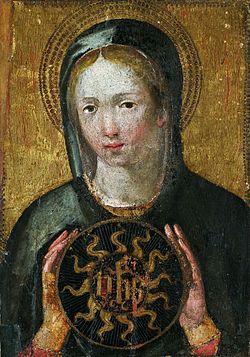Saint Domitilla
| Roman imperial dynasties | |||
| Flavian dynasty | |||
 Saint Domitilla |
|||
| Chronology | |||
| Vespasian | 69 AD – 79 AD | ||
| Titus | 79 AD – 81 AD | ||
| Domitian | 81 AD – 96 AD | ||
| Family | |||
|
Gens Flavia Category:Flavian dynasty |
|||
| Succession | |||
|
Preceded by Year of the Four Emperors |
Followed by Nerva–Antonine dynasty |
||
| Saint Flavia Domitilla | |
|---|---|

Andrea di Bonaiuto da Firenze. St. Agnes and St. Domitilla. 1365. Galleria dell'Accademia, Florence.
|
|
| Born | 1st century Rome |
| Died | 90s Ponza or Ventotene |
| Venerated in |
Greek Orthodox Church Catholic Church |
| Major shrine | Santi Nereo e Achilleo |
| Feast | May 7 (Catholic), May 12 (Orthodox) |
Flavia Domitilla was daughter of Domitilla the Younger by an unknown father, perhaps Quintus Petillius Cerialis. She married her cousin, the consul Titus Flavius Clemens.
Quintilian reports that he had been entrusted with the tutelage of two of Domitian's grandsons. These should be the children of this Domitilla and Clemens.
Suetonius states that Domitian designated Clemens' children his successors whilst they were still very young, before their parents' fall, and renamed them Domitianus and Vespasianus.
Dio reports:
Suetonius also states that Domitilla's steward Stephanus was involved in the final, successful plot against Domitian.
Some scholars connect Domitilla with a character in Jewish tradition, a Roman matron in the Talmud (Avodah Zarah 10b) and Deuteronomy Rabbah 2.25. When the emperor had decreed that in 30 days, the Senate would confirm an edict to kill all Jews and Christians in the Roman Empire, the Roman matron convinced her husband to stand up for the Jews. If that identification is correct, her husband Flavius Clemens converted to Judaism after having contact with the great sage Rabbi Akiva. This may integrate with the tradition of her as a Christian.
Flavia Domitilla is a saint in the Greek Orthodox Church, which celebrates her feast day on 12 May. And also as a saint by the Catholic Church, which honours her on 12 May together with Saints Nereus and Achilleus, in whose church of Santi Nereo e Achilleo in Rome, her supposed relics were housed. Her name was not linked with theirs in the Tridentine Calendar of Pope Pius V. It was added in 1595, and was removed from that date in 1969, and is now listed on 7 May in the Martyrology.
...
Wikipedia
